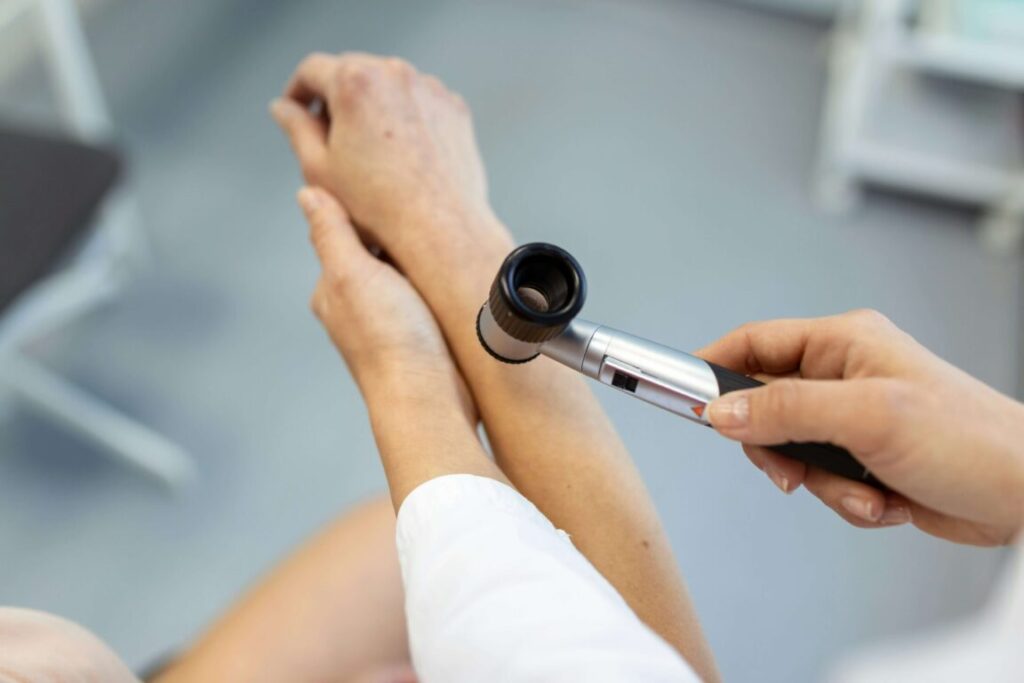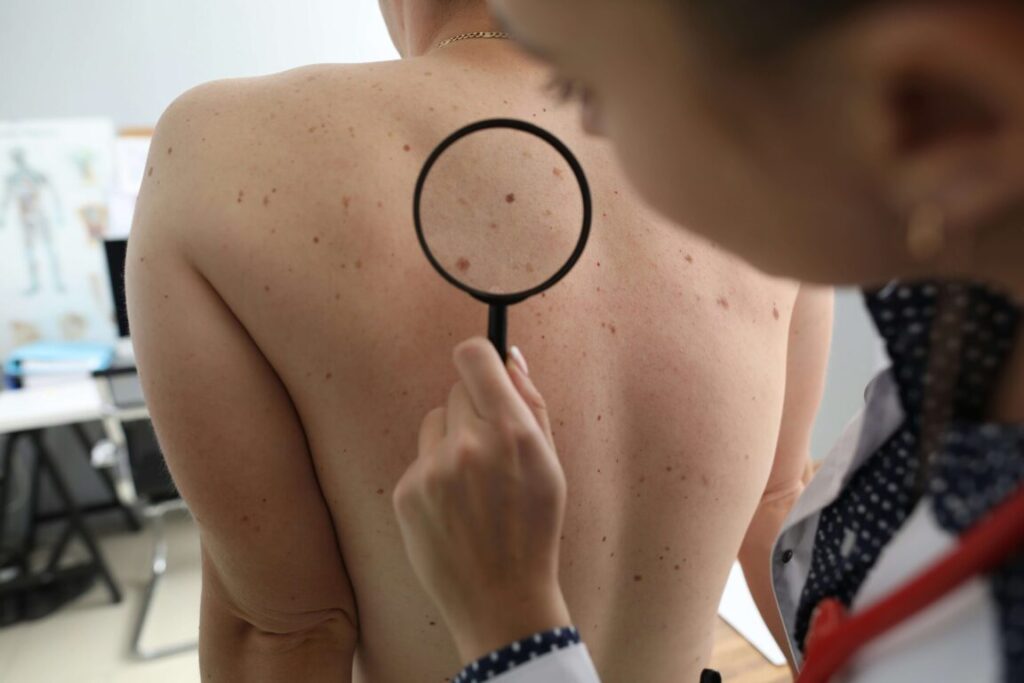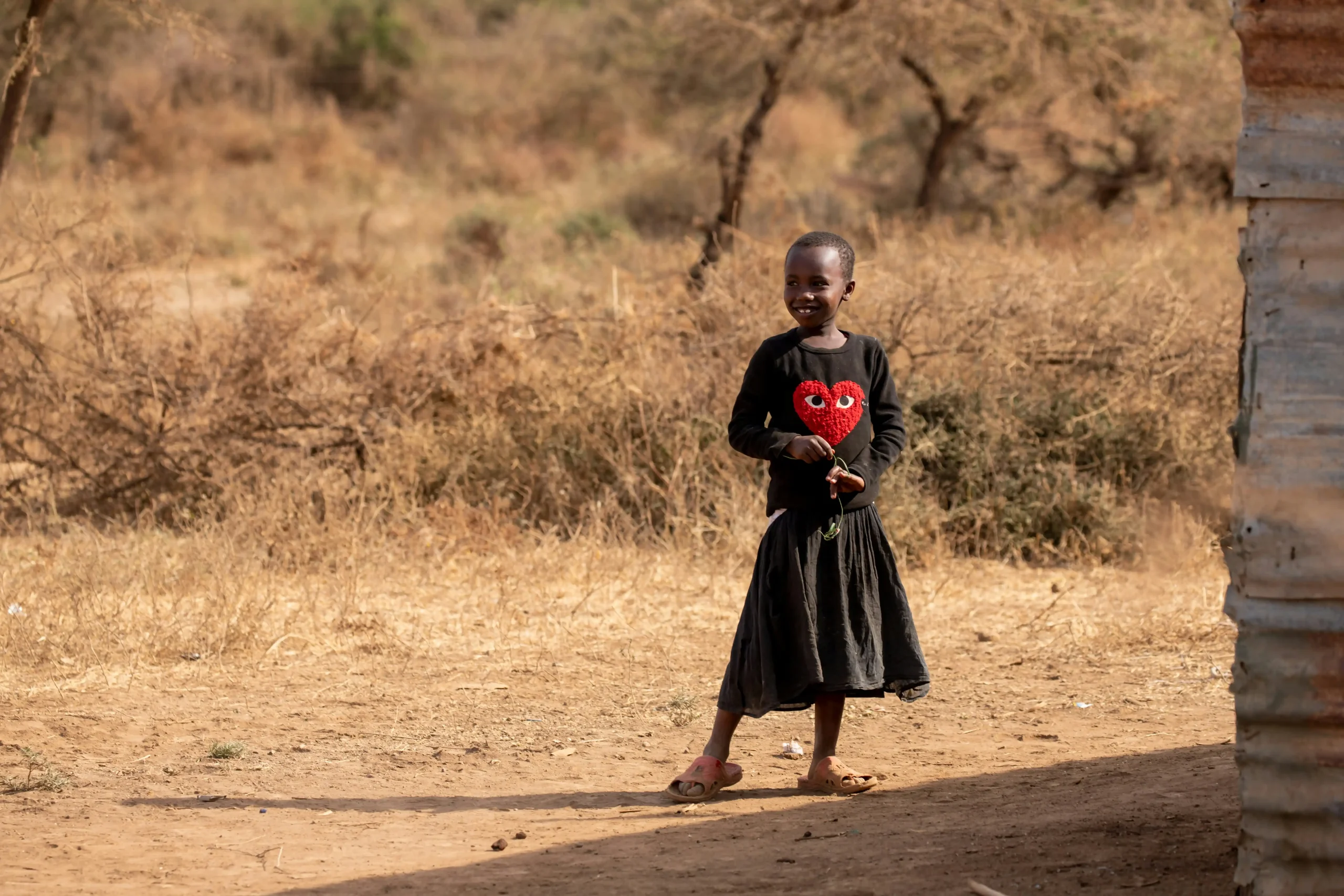Melanoma, an aggressive skin cancer, has become the second most frequently diagnosed cancer in the world. Its rapid increase in incidence has raised serious concerns among medical experts and oncology specialists. The rapid expansion of this type of cancer is due not only to more intense UV exposure, but also to late detection of skin lesions. Melanoma, although it may initially appear harmless, develops extremely rapidly, often leading to metastasis. Key in the fight against this cancer is early diagnosis and appropriate treatment.
Table of Contents:
- What is melanoma and what symptoms does melanoma give?
- The most common causes of melanoma
- Melanoma cancer – What is the treatment?
- Alarming melanoma cancer statistics in Poland
What is melanoma and what symptoms does it give?
Melanoma is a malignant skin cancer that develops from melanocytes, the pigment cells responsible for melanin production. It is one of the most aggressive skin cancers, as it tends to grow rapidly and has the ability to metastasize to other organs. Melanoma most often appears on the skin in the form of a new lesion or transformation of an existing nevus.
The editors recommend: Does beautification hurt? – aesthetic medicine
The main symptoms of melanoma include:
- Asymmetry – the skin lesion is irregular, with the two halves differing from each other.
- The edges – the borders of the birthmark are jagged, uneven or fuzzy.
- Color – the change comes in a variety of colors, from shades of brown and black, to red, blue or white.
- Diameter – melanomas often exceed 6 mm in diameter, although they can be smaller.
- Evolution – a change in size, shape, color or the appearance of new symptoms, such as itching, bleeding or ulceration.
Any skin lesion that raises concerns should be consulted with a dermatologist as soon as possible to rule out or confirm the development of melanoma. Early diagnosis and treatment are key to successful treatment of this cancer.
The most common causes of melanoma
Melanoma is a malignant skin cancer, the development of which is most often associated with overexposure to UV radiation. This radiation comes both from the sun and from artificial sources such as solariums. UV rays damage the DNA of skin cells, which can lead to mutations and cancer. Exposure to intense sunlight, especially repeated sunburns, significantly increases the risk of melanoma. Light-skinned people are particularly sensitive to UV radiation and are easily burned because they have less melanin, the skin’s natural pigment, which provides some protection from radiation.
Genetic predisposition is also an important risk factor. If there is a family history of melanoma, the risk of developing the disease increases, suggesting that certain genetic mutations may be inherited. People with numerous pigmented nevi (especially irregular or unusual-looking ones) are at higher risk of developing melanoma, as these nevi can develop into cancer. Previous sunburns, especially those that occurred in childhood, also have long-term effects on skin health, increasing the risk of melanoma in later life.

Age is another factor, as melanoma is more common in older people, although this is not a rule – it can occur at any age, even in younger people. Melanoma can also develop in areas not exposed to the sun, indicating that UV radiation is not the only risk factor. However, early detection and prevention play a key role in preventing and successfully fighting melanoma. Regular dermatological examinations, protecting the skin from excessive sunlight and avoiding the use of tanning beds can significantly reduce the risk of contracting this dangerous cancer.
What is the treatment of melanoma?
Melanoma treatment depends on the stage of the cancer, its location and the patient’s overall health. Here are the main treatments for melanoma:
- Surgery: This is the primary treatment for melanoma, especially in its early stages. It involves surgical removal of the tumor and a margin of healthy skin around it to minimize the risk of recurrence. For large or deep-seated tumors, it may be necessary to remove lymph nodes in nearby areas.
- Immunotherapy: This is a modern form of treatment that involves the use of drugs that enhance the body’s natural ability to fight cancer. Drugs such as checkpoint inhibitors (e.g., pembrolizumab, nivolumab) help the immune system recognize and destroy cancer cells. Immunotherapy is particularly effective in advanced stages of melanoma and can lead to long-term remissions.
- Targeted therapy: Uses drugs that act on specific genetic changes in cancer cells. For melanoma that contains a BRAF mutation, drugs such as dabrafenib or trametinib are used. Targeted therapy is effective in cases where the cancer has specific genetic mutations, allowing precise targeting of treatment.
- Chemotherapy: It is less commonly used to treat melanoma because the cancer is less sensitive to conventional chemotherapeutic drugs compared to other types of cancer. Chemotherapy can be used when other treatments are not effective or when the cancer has metastasized to other organs.
- Radiation therapy: It is used infrequently to treat melanoma, but can be useful in treating local recurrence or metastasis to bone and brain. Radiation therapy uses high doses of radiation to destroy cancer cells.
- Supportive treatment: The goal of this treatment is to relieve symptoms and improve the patient’s quality of life. It may include pain control, management of treatment side effects, and psychological and social support.
In the case of melanoma, it is crucial to diagnose it quickly and adjust the treatment method to the individual patient’s needs accordingly. Working with a team of specialists, including dermatologists, oncologists, surgeons and immunotherapy specialists, ensures comprehensive care and the best treatment results.
Alarming melanoma statistics in Poland
Alarming statistics on melanoma in Poland, show an alarming trend of increasing incidence of this dangerous skin cancer. The number of melanoma cases has nearly doubled in the past decade, posing a serious health and social problem. Experts who spoke at a press briefing held in the capital as part of Melanoma Awareness Week stressed that such an increase in cases is the result of several key factors.
The increase in the number of diseases is primarily related to increasing exposure to UV radiation, which comes both from the natural sun and from artificial sources such as solariums. Prolonged and intensive use of these radiation sources contributes to DNA damage to skin cells and increases the risk of developing melanoma. In addition, changing lifestyle patterns, such as more frequent use of tanning beds and less attention to sun protection, also contribute to this increase.
In addition, lifestyle changes, such as more frequent travel to sunny countries and the growing popularity of tanning, are having a significant impact on the increase in cases. Experts point out the need to intensify education and prevention efforts to raise public awareness of the dangers of overexposure to the sun and UV radiation.

The press briefing for Melanoma Awareness Week spoke about the importance of early detection of skin lesions and regular dermatological examinations. Experts urge people to examine worrisome skin lesions, as early detection can be key to the disease.
Prof.
Piter Rutkowski, head of the Department of Soft Tissue, Bone and Melanoma Tumors at the Maria Sklodowska-Curie National Cancer Institute.
Maria Sklodowska-Curie – PIB in Warsaw notes that the increase in melanoma cases is greater than that of lung cancer, which is the most common malignancy in our country.
“In the last 10 years, the number of melanoma cases has almost doubled and now stands at about. 4200” – said the oncologist, who is chairman of the Scientific Council of the Melanoma Academy. He added that based on forecasts from the US, this trend can be predicted to continue. Data for the United States indicate that in 2040.
melanoma will be the second most common cancer there.
The good news is that although the number of cases is increasing, mortality from this cancer is not.
“The survival rate of people with melanoma has increased significantly in Poland. Almost 80 percent of Polish women and men who develop it have a chance of being cured. In metastatic melanoma, the survival rate is now more than 50 percent, and when I started my work it was about 2 percent. This has not happened in any other cancer,” the expert said.
The increase in the number of melanoma cases in Poland is a serious wake-up call that calls for coordinated efforts for education, prevention and early detection of this cancer. Only by increasing public awareness and promoting healthy habits can this growing epidemic be effectively countered.
Editorial recommends: There is a gym in Katowice… with a “View of the Sea of Trees”. – interview with Tomasz Rogalski manager of Active Francuska





